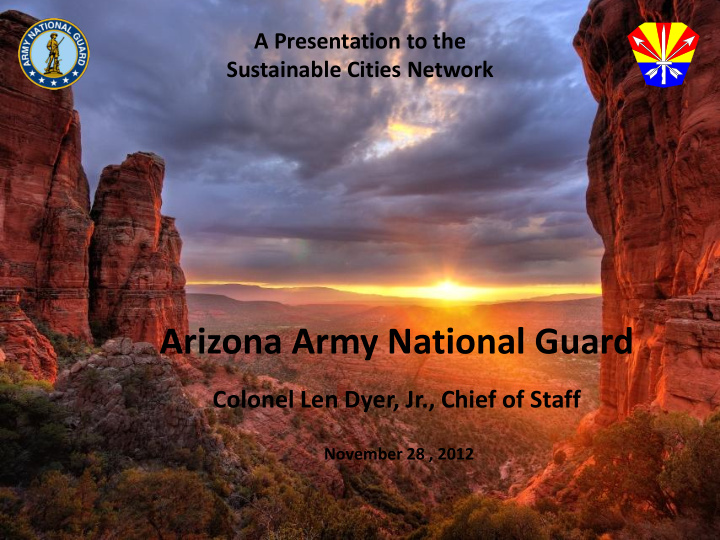



A Presentation to the Sustainable Cities Network Arizona Army National Guard Colonel Len Dyer, Jr., Chief of Staff November 28 , 2012
National Guard History • Citizen-soldiers dedicated to protecting and defending the interests of our community, state, and our nation • Oldest component of the U.S. Armed Forces • 1 st organized on Dec. 13, 1636 at Jamestown • Arizona ARNG established on Sep. 2, 1865 • Currently 5,200 Soldiers • Also respond to state emergencies Death of Gen. Warren at the Battle of Bunker Hill by John Trumbull Blackhawk helicopters fighting wildfires in Tonto NF, Aug. 14, 2012.
Organization Governor Dept of Emergency & Military Affairs Division of Division of Military Affairs Emergency Mgt Air National Guard Army National Guard
Soldier Deployments Kuwait Iraq Afghanistan Kazakhstan Louisiana S Korea Arizona Japan Cuba Philippines Panama Vietnam Columbia Horn of Africa Total Arizona National Guard Airmen & Soldiers deployed since 9/11 - >10,000
Training Sites & Armories Training Sites Armories Camp Navajo Bellemont (2), Flagstaff Prescott Show Low Buckeye, Sunnyslope, Papago Park (3), Tempe, Buckeye Chandler, Mesa, Gilbert Casa Grande Florence Coolidge Safford Yuma Picacho Stagefield Silverbell Army Heliport Silverbell Valencia & Silver Lake (Tucson) Nogales & Douglas
Sustainability Program • Guidance: • EO 13423 and EO 13514 • DOD Strategic Sustainability Performance Plan • Army Sustainability Campaign Plan • TAG Sustainability Policy
Sustainability Program • 4 Teams • Infrastructure and Utilities • Logistics and Procurement • Materials Management • Readiness-Training Land Protection • Possible inclusion of Salt River Project testing solar air conditioning with Guard. “Community Outreach Team” Solar panels on Award Winning Environmental Office, AZ ARNG.
Sustainability Program Infrastructure and Utilities 1. 1.1 Energy Intensity of Facilities Reduced by 30% of FY 2003 Levels by FY 2015 and 37.5% by FY 2020 2. 1.2 18.3% of Energy Consumed by Facilities is Produced or Procured from Renewable Sources by FY 2020 3. 2.1 Potable Water Consumption Intensity by Facilities Reduced by 26% of FY 2007 Levels by FY 2020 4. 2.2 Industrial and Irrigation Water Consumption Reduced by 20% of FY 2010 Levels by FY 2020 5. 2.3 All Development and Redevelopment Projects of 5000 Square Feet or Greater Maintain Pre-Development Hydrology to the Maximum Extent Technically Feasible 6. 7.2 15% of Existing Buildings Conform to the Guiding Principles on High Performance and Sustainable Buildings By FY 2015, Holding Through FY 2020 7. 8.2 The Sustainability of Transportation and Energy Choices in Surrounding Areas Optimized by Coordinating with Related Regional and Local Planning
Sustainability Program Logistics and Procurement 1. 1.3 Use of Petroleum Products by Vehicle Fleets Reduced 30% by FY 2020 2. 4.1 Greenhouse Gas Emissions from Employee Travel Reduced 7% by FY 2020 Relative to FY 2011 3. 4.2 30% of Eligible Employees Tele-working at Least Once a Week, on a Regular, Recurring Basis, by FY 2020 4. 5.1 All DOD Organizations Implementing Policies by FY 2014 to Reduce the Use of Printing Paper 5. 6.1 On-Site Releases and Off-Site Transfers of Toxic Chemicals Reduced by 15% by FY 2020, Relative to FY 2007 6. 6.2 100% of Excess or Surplus Electronic Products Disposed of in Environmentally Sound Manner
Sustainability Program Materials Management 1. 4.3 50% of Non-Hazardous Solid Waste Diverted from Disposal in Landfills Not Owned by DOD by FY 2015 and Thereafter Through FY 2020 2. 5.2 50% of Non-Hazardous Solid Waste Diverted from Waste Stream by FY 2015 and Thereafter Through FY 2020 (for AZARNG includes Hazardous Waste) 3. 5.3 60% of Construction and Demolition Debris Diverted from the Waste Stream by FY 2015 and Thereafter Through FY 2020 4. 6.3 100% of DOD Personnel and Contractors that Apply Pesticide Properly Certified-already done 5. 8.3 All DOD Installations Have Integrated Pest Management Plans Prepared, Reviewed and Updated Annually by Pest Management Professionals-50% of plans have already been reviewed. 6. 7.1 95% of Procurement Conducted Sustainably
Sustainability Program Readiness 1. Protect and Maintain Training Capabilities 2. Adapt For and Support Future Training Requirements 3. Provide Adequate/Appropriate Training Facilities
Sustainability Program Successes 1. AZARNG/ASU Sustainability Partnership Workshop 2. Pinal County Partnership 3. Arizona Land and Water Trust 4. Tonto National Forest 5. SRP 6. Historic building to LEED Silver 7. ACUB Camp Navajo- Roger’s Lake 2250 acres protected with partnership of 21 including: Coconino County Parks and Recreation, Arizona Game and Fish Department, US Forest Service, City of Flagstaff, The Nature Conservancy, Grand Canyon Trust and more.
Closing Remarks • Continued growth of AZANRG Sustainability Program • Future Partnerships
A Presentation to the Sustainable Cities Network Arizona Army National Guard Colonel Len Dyer, Jr., Chief of Staff November 28, 2012
Recommend
More recommend